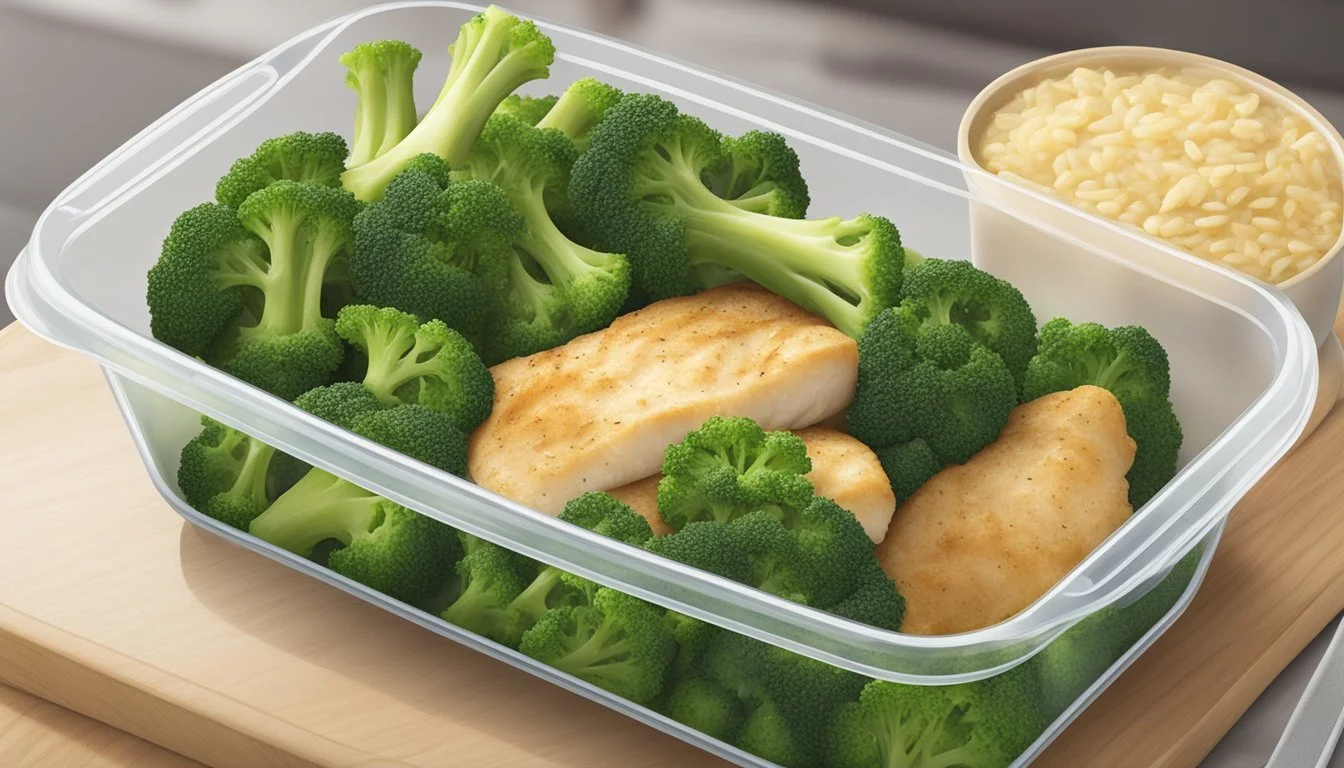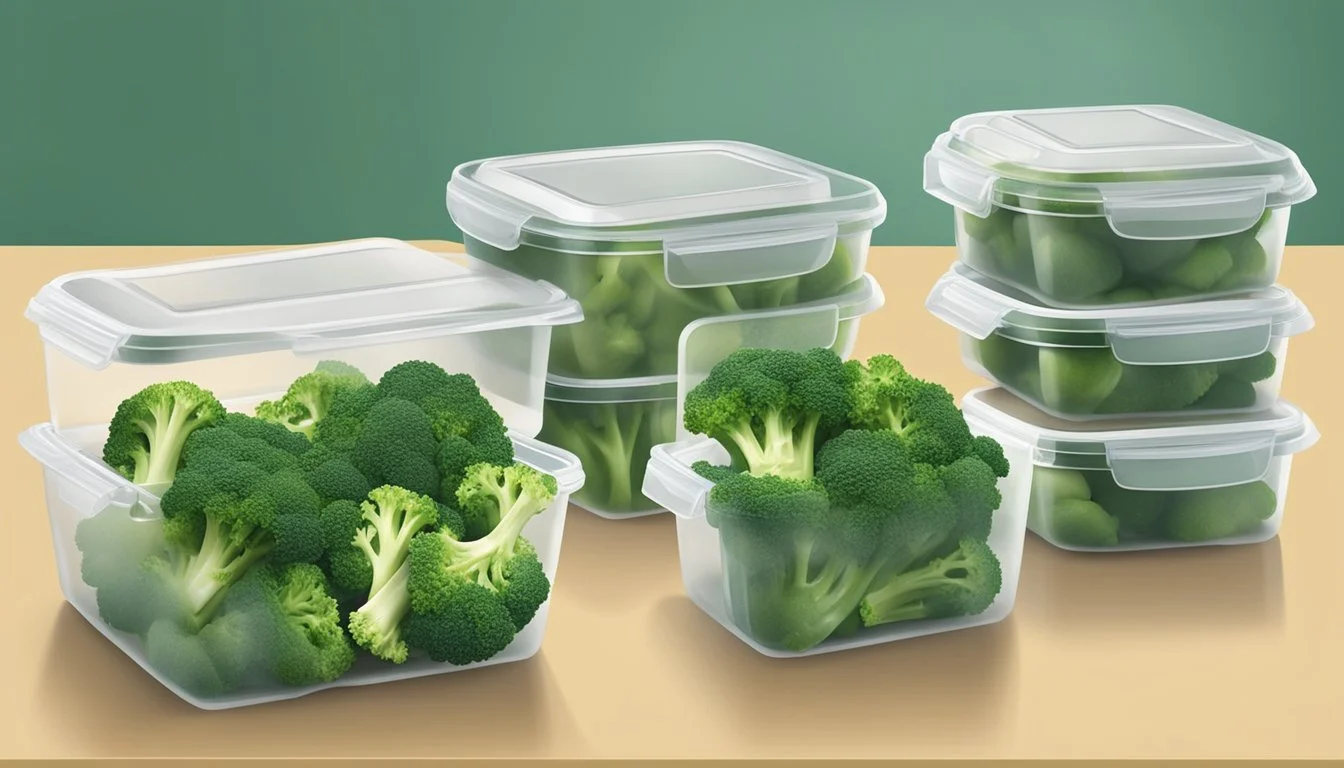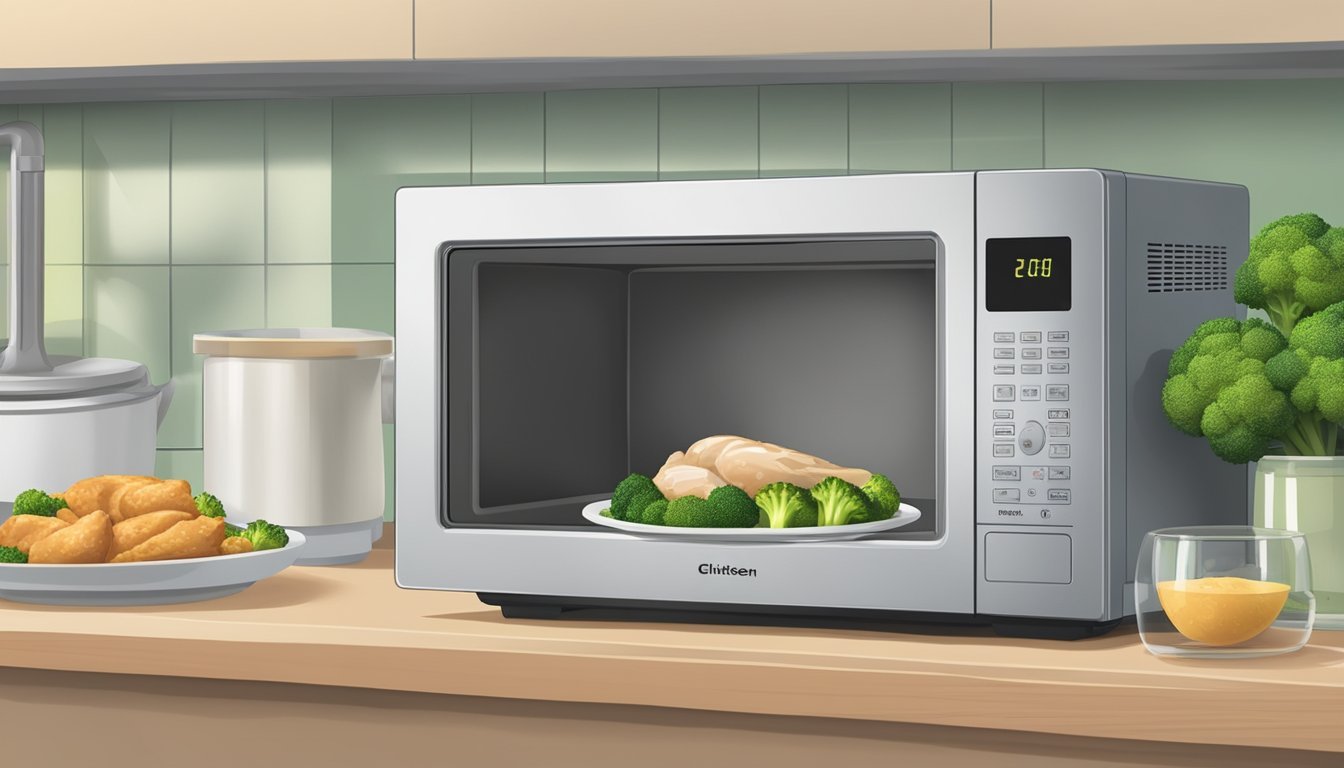How Long Does Gluten-Free Chicken and Broccoli Last?
Storage Tips and Guidelines
For fans of gluten-free cuisine, an essential question revolves around storage and shelf life. Chicken and broccoli dishes, prized for their nutritious and satisfying combination, need proper handling to ensure they remain fresh and safe to eat. Typically, gluten-free chicken and broccoli can last in the refrigerator for about 3 to 4 days.
Proper storage is crucial. Ensure the dish is kept in an airtight container to prevent moisture loss and reduce the risk of contamination. When refrigerated promptly after cooking, you can enjoy the meal throughout the week without compromising on taste or safety.
Freezing the dish extends its shelf life substantially. When stored in the freezer, gluten-free chicken and broccoli can last up to 3 months. Reheat thoroughly before consumption to maintain the dish’s quality and ensure that it is safe to eat.
Health Benefits and Nutritional Value
The combination of gluten-free chicken and broccoli offers numerous health benefits. This dish provides an excellent source of protein, essential vitamins, and minerals while catering to dietary needs for those avoiding gluten.
Protein Content in Chicken
Chicken is a significant source of protein, which is essential for muscle growth and repair. A 3.5-ounce serving of skinless, cooked chicken breast contains about 31 grams of protein.
This nutrient-packed food also contributes to maintaining a healthy metabolism. Moreover, chicken is low in fat, especially when the skin is removed, making it a healthier option for those watching their calorie intake.
Vitamins and Minerals in Broccoli
Broccoli is rich in essential vitamins and minerals. It contains high levels of Vitamin C, which supports immune function, and Vitamin K, crucial for bone health and blood clotting. Additionally, broccoli is a good source of Fiber, aiding in digestion and promoting a healthy gut.
Broccoli also contains Potassium, which helps maintain proper heart function and muscle contractions.
Benefits of a Gluten-Free Diet
A gluten-free diet can be beneficial for individuals with celiac disease or gluten intolerance. This diet helps alleviate digestive issues, fatigue, and other symptoms associated with these conditions. By eliminating gluten, such individuals can improve nutrient absorption and overall health.
Moreover, a gluten-free diet often encourages healthier food choices, like incorporating more fruits, vegetables, and lean proteins. By focusing on nutrient-dense foods, individuals can achieve better nutrition.
Ingredients and Substitutions
For gluten-free chicken and broccoli dishes, selecting the proper ingredients ensures both flavor and dietary compliance. Key considerations include choosing the right chicken, selecting fresh broccoli, and using suitable gluten-free sauce and seasoning options.
Choosing the Right Chicken
Skinless chicken breasts are a popular choice for their leanness and ability to absorb marinades well. They should be trimmed of any fat and cut into uniform pieces to ensure even cooking.
Always opt for high-quality, fresh chicken breasts. This guarantees a tender texture and optimal taste. If skinless chicken breasts are unavailable, boneless thighs can be a substitute, offering a slightly richer flavor.
Selecting Fresh Broccoli
Broccoli florets add a nutritious and vibrant touch to the dish. Choose broccoli that is firm with tight, green florets.
Avoid any heads that have yellowing spots or limp stalks, as these indicate age. For convenience, pre-cut broccoli florets can be used, but freshly cut pieces typically maintain a better texture when cooked.
Gluten-Free Sauce Options
A key component is the gluten-free sauce. Tamari is a great option, providing a similar savory profile to soy sauce but without gluten. Another alternative is coconut aminos, which are slightly sweeter but also gluten-free.
For a richer flavor, gluten-free teriyaki sauce can be used. Always check labels for any hidden gluten ingredients, especially with pre-made sauces.
Oil and Seasoning Considerations
Olive oil is a versatile choice, providing a neutral flavor that won't overpower the other ingredients. For a nuttier taste, sesame oil can be added, which pairs well with soy-based sauces.
Season the dish with basics like salt and pepper. Additional elements such as sesame seeds, minced garlic, or grated ginger can enhance flavor. Adjust the seasoning to taste, keeping in mind dietary restrictions.
Being mindful of these ingredients and substitutions ensures a delicious and compliant gluten-free chicken and broccoli dish.
Preparation Tips
Proper preparation ensures your gluten-free chicken and broccoli stir-fry is both delicious and healthy. Key points include efficient timing and effective cooking techniques.
Prep Time Efficiency
Marinate the chicken for about 10 minutes using a simple marinade. Combine 3 tablespoons of water, a tablespoon of oyster sauce, and a teaspoon each of oil and gluten-free flour. This step starts the flavor development early and can be done while chopping the vegetables.
Cut your broccoli into florets. Using pre-cut florets can save time. Prepare remaining ingredients like garlic and ginger by mincing them beforehand for a seamless cooking process. Have all ingredients ready and in place.
Effective Cooking Techniques
Use a large skillet or a wok for quick and even cooking. Start by heating oil in the skillet over medium heat. Sauté the chicken, adding ¼ teaspoon of salt for seasoning, until it becomes brown and crispy. This process should take about 8 minutes. Flip the chicken halfway through for even cooking.
Add the broccoli next. Pour ¼ cup of water over the florets, cover the pan, and cook until the broccoli is bright green and tender-crisp. It usually takes 2-3 minutes. Stir in the minced garlic and ginger, cooking them until fragrant. Whisk and add the stir-fry sauce just before finishing.
Prepare sauces and mixes in advance so they are ready to go when needed. This will make the entire process smoother and more efficient.
Safe Storage Guidelines
Proper storage of gluten-free chicken and broccoli ensures it remains fresh and safe to eat. Follow these guidelines for refrigeration and freezing to extend shelf life and maintain food safety.
Refrigeration Best Practices
Store cooked chicken and broccoli in an airtight container to prevent moisture loss and odor absorption. This helps retain the quality of the food.
Place the container in the coldest part of the fridge, typically the back. Set the fridge temperature to 40°F (4°C) or lower.
Label the container with the date to keep track of how long it's been stored. Cooked chicken and broccoli should be consumed within 3-4 days.
Freezing and Thawing Methods
For longer storage, freeze chicken and broccoli. Use freezer-safe airtight containers or heavy-duty freezer bags to protect against freezer burn.
Freeze chicken alfredo in portion sizes to make thawing easier. Label the containers with dates.
To thaw, move the frozen food to the fridge overnight. For quicker thawing, use the defrost setting on a microwave. Never thaw at room temperature to prevent bacterial growth.
By following these methods, you ensure your gluten-free chicken and broccoli dishes remain safe and tasty.
Shelf Life Determination
The durability of gluten-free chicken and broccoli depends on various factors. Identifying signs of spoilage is essential for ensuring food safety.
Factors Affecting Freshness
The longevity of tender chicken and cooked broccoli revolves around several key elements. Storage conditions are crucial; keeping these foods in an airtight container in the refrigerator extends their storage life. Temperature is another vital factor; maintaining a consistent cold environment slows down bacterial growth.
Preparation methods also significantly influence shelf life. Proper cooking and immediate cooling reduce the risk of contamination. On the other hand, exposure to air can accelerate spoilage. Ingredient quality plays a role too; fresher ingredients naturally last longer. Finally, labeling with dates helps track storage time effectively.
Signs of Spoilage
Recognizing when gluten-free chicken and broccoli have gone bad is critical for food safety. Off smells are the first indicator; spoiled chicken emits a sour or ammonia-like odor, while bad broccoli may smell unpleasantly sulfurous. Visual cues include discoloration and sliminess, which signal bacterial growth and decomposition.
Texture changes are another warning sign. Chicken turning sticky or tacky and broccoli becoming limp and mushy are red flags. Mold growth is a definitive sign of spoilage. Observing any of these symptoms means the food should be discarded immediately. Monitoring these factors ensures the food is safe to consume.
Serving and Pairing Suggestions
For a delightful dining experience, pair gluten-free chicken and broccoli with complementary sides and beverages that enhance the dish's flavors.
Accompaniments and Sides
Serve gluten-free chicken and broccoli with a variety of sides to amplify the meal. Rice options such as white rice or brown rice are excellent choices, adding sustenance and texture. For a pasta alternative, opt for gluten-free penne or other pasta types, perfectly balancing the dish's protein and veggies.
Consider adding green veggies like green beans, snap peas, and asparagus. Lightly steamed or sautéed, these veggies provide a crisp texture and fresh taste. Additionally, a drizzle of lemon juice or a sprinkle of parmesan cheese can elevate the flavors without overwhelming the palate.
Wine and Beverage Pairings
Selecting the right beverage enhances the culinary experience. For wines, a Sauvignon Blanc or Chardonnay pairs well, offering crisp acidity that complements the chicken and broccoli. Alternatively, a Pinot Noir can provide a light, fruity contrast.
For non-alcoholic options, choose a refreshing drink like a sparkling water with a hint of lemon or lime. Green tea is another excellent choice, offering subtle flavors that do not overpower the meal. Both wine and non-alcoholic beverages should focus on highlighting the delicate yet flavorful aspects of the dish without overshadowing them.
Reheating Instructions
Reheating gluten-free chicken and broccoli correctly ensures the dish remains tasty and safe to eat. Different methods suit different needs, whether you prefer the speed of a microwave or the uniform heating of an oven.
Microwave Reheating
To reheat chicken and broccoli in the microwave, start by placing the meal in a microwave-safe container. Cover it with a microwave-safe lid or wrap to prevent drying out.
Steps:
Set Power Level: Use medium power to avoid overcooking the broccoli.
Timing: Heat for 1-2 minutes initially.
Stirring: Stir the contents and then heat for an additional 1-2 minutes if needed.
Check Temperature: Make sure the chicken reaches an internal temperature of 165°F (74°C).
This method is ideal for those needing a quick meal. Use ingredients like olive oil to prevent drying out.
Stovetop Warming Methods
Reheating on the stovetop gives greater control over the heating process. Use a non-stick skillet for best results.
Steps:
Preheat Skillet: Warm the skillet over medium heat.
Add Ingredients: Add a small amount of oil or butter to prevent sticking.
Reheat: Place the chicken and broccoli in the skillet. Stir occasionally to ensure even heating.
Monitor: Heat for 5-7 minutes or until the chicken reaches 165°F (74°C).
This method retains the texture of the grilled chicken and keeps the broccoli crisp.
Oven Heating Technique
The oven is suited for larger batches or when you want the flavors to meld more deeply.
Steps:
Preheat Oven: Set it to 350°F (175°C).
Prepare Dish: Place chicken and broccoli in an oven-safe dish. Cover with foil to retain moisture.
Heat: Cook for 15-20 minutes. Check the internal temperature to ensure it reaches 165°F (74°C).
Uncover (Optional): Remove the foil during the last 5 minutes if you prefer a crispy top.
Using the oven might take longer than other methods, but it ensures even warming and is great for dishes with simple ingredients.
Recipe Variations
Exploring recipe variations for gluten-free chicken and broccoli opens up possibilities for dietary preferences and nutritional needs. This includes vegetarian and vegan alternatives, low-carb and paleo options, and rich and creamy adaptations.
Vegetarian and Vegan Alternatives
For vegetarian or vegan options, replace chicken with tofu or tempeh. Tofu is an excellent source of protein and is naturally gluten-free. Cut it into cubes and marinate it similarly to chicken for enhanced flavor.
Incorporate a variety of vegetables such as peas, snow peas, and broccoli. Use a stir fry method with gluten-free soy sauce. For a vegan twist, incorporate dairy-free sauces like a coconut aminos-based sauce or a vegan stir fry sauce.
Low-Carb and Paleo Options
To make a low-carb or paleo version, use zucchini noodles or cauliflower rice instead of traditional rice or pasta. These options are naturally gluten-free and lower in carbs. The chicken and broccoli can be cooked with paleo-friendly ingredients like coconut oil and a simple seasoning of garlic and herbs.
A soy-free, paleo stir-fry sauce can be made using coconut aminos, apple cider vinegar, and ginger. This will keep the dish both flavorful and suitable for those following a paleo diet.
Rich and Creamy Adaptations
For those who enjoy rich and creamy dishes, consider a Gluten-Free Chicken Broccoli Alfredo. Use gluten-free penne and an Alfredo sauce made from scratch using heavy cream, butter, and parmesan cheese. This enhances the richness of the dish.
Add seasoning such as garlic powder and black pepper to elevate the flavors. Another option is to create a dairy-free version using cashew cream for a creamy texture without dairy, helping those with lactose intolerance enjoy the dish without issues.










